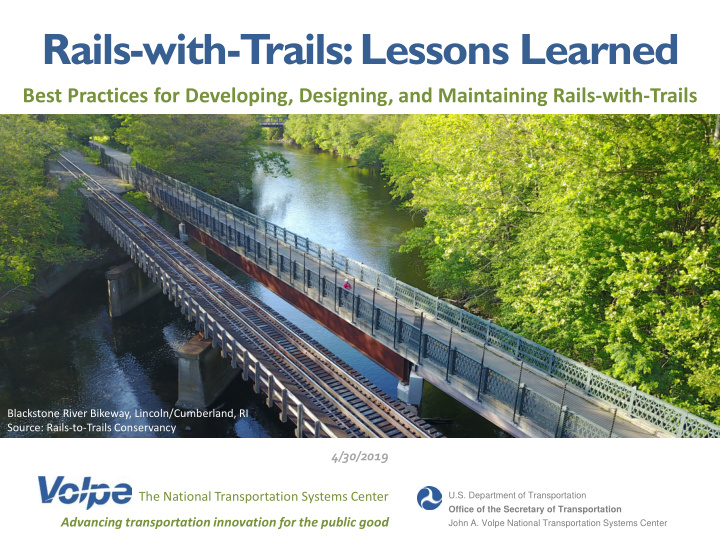



Rails-with-T rails: Lessons Learned Best Practices for Developing, Designing, and Maintaining Rails-with-Trails Blackstone River Bikeway, Lincoln/Cumberland, RI Source: Rails-to-Trails Conservancy 4/30/2019 The National Transportation Systems Center U.S. Department of Transportation Office of the Secretary of Transportation Advancing transportation innovation for the public good John A. Volpe National Transportation Systems Center
Outline Introduction Policies and Perspectives Development Process Liability and Risk Management Design Construction, Operations, and Maintenance For More Information 2
Rails-with-Trails: A shared-use path or trail open and developed for public use that is located on or directly adjacent to an active railroad or rail transit corridor. East Boston Greenway, Boston, MA Source: US DOT Volpe Center 3
How many? Where are they? 343 rails-with-trails in 47 States comprising 917 miles 4
Benefits and Challenges Benefits: • Active Transportation • Health and Wellness • Access • Economic Development • Environmental Protection Challenges: • Property acquisition • Concerns about safety San Clemente Beach Trail, San Clemente, CA and liability Source: Rails-to-Trails Conservancy • Concerns about trespassing 5
Policies and Perspectives: Railroads • Half of Class I railroads have written policies against locating trails within railroad ROW; few Class II and III railroads do. • Concerns: • Trespassing • Work Hazards • Quiet Zones • Liability Minneapolis Southwest Corridor, Minneapolis, MN Source: Southwest Journal • Impacts to Future Rail Operations 6
Policies and Perspectives: Public Transportation Agencies • Few public transit agencies have written RWT policies, but more are developing them. • Some see RWTs as opportunities for increasing ridership. • Concerns: • Grade Crossings • Fencing Neponset River Greenway, Boston, MA • Signage Source: Bay Colony Rail Trail 7
Policies and Perspectives: State DOTs 15 State DOTs have policies, • design guidelines, or other information about RWTs. Some State DOTs actively • promote RWTs; others recommend avoiding them. Guidelines provide • minimum design standards, but most are meant to be Sierra Bike Trail, Palmdale/Lancaster, CA flexible/adaptable. Source: TrailLink User vikemaze 8
Policies and Perspectives: Trail Builders See RWTs as ways to fill • gaps in off-road nonmotorized trail networks. Successful RWT developers • work closely with stakeholders to address concerns. Great River Trail, Rock Island, IL Source: American Trails 9
Best Practices: Development Process Locate RWTs outside of the railroad ROW, if possible. Determine feasibility. Conduct an environmental analysis prior to land acquisition and design. Involve stakeholders early in the process. Downtown Lakewalk, Duluth, MN Engage railroads early and often. Source: American Trails 10
Best Practices: Liability and Risk Management Conduct initial legal research early in the process. Gather information about trespassing in the corridor. Follow design recommendations in the forthcoming U.S. DOT report, AASHTO Guide, and MUTCD. Consider using indemnification Frisco Trail, Fayetteville, AR agreements and/or insurance Source: Rails-to-Trails Conservancy to address liability. 11
Best Practices: Design Regulatory and Railroad Requirements: Adhere to all relevant Federal, State, and local regulatory requirements, as well as the requirements of the adjacent railroad. Example: 2007 Union Pacific 12
Best Practices: Design Setback: Set back RWTs as far as possible from railroad tracks. Consider: Train speed, frequency, and type Rail maintenance and operations Track curvature Environmental and physical constraints Winona Interurban Trail, Winona, IN Separation type Source: Rails-to-Trails Conservancy Trespassing and vandalism 13
Best Practices: Design Separation: Separation between the RWT and railroad tracks can be fencing, ditches, berms, and/or vegetation. When fencing is needed, consider the following when selecting a fence type and height: Setback distance Whittier Greenway Trail, Whittier, CA Source: City of Whittier Location of grade crossings Type, speed, and frequency of trains 14
Best Practices: Design Crossings: Propose new at-grade crossings only where there are no other reasonable alternatives. Use existing road-track crossings where possible. Include safety measures such as crossbucks, flashing lights, bells, crossing arms, and signage. Bridges/trestles and tunnels are Martin Luther King Promenade, San Diego, CA Source: American Trails expensive and railroads often do not allow them. 15
Best Practices: Design Accommodating Future Tracks and Sidings: RWTs should be designed and located so as not to preclude potential future rail expansion, if anticipated. Where corridor width, topography, and other factors allow, RWTs should be located on the opposite side of the North Cedar Lake Regional Trail, Minneapolis, MN Source: Simon Blenski, Minneapolis Public Works proposed track or siding expansion. 16
Best Practices: Design Access to Stations: RWTs should promote access to rail and transit stations, taking into account both accessibility and safety. Bicycle parking should be installed near the stations in coordination with the rail or public transportation agency. Lance Armstrong Bikeway, Austin, TX Source: Rails-to-Trails Conservancy 17
Best Practices: Design Drainage: Consider the impact the rail-with-trail may have on the adjacent rail line’s drainage system. In certain cases, a new drainage system might need to be installed to serve both the railroad and trail. California Railroad Museum, Sacramento, CA Source: California Parks 18
Best Practices: Construction, Operations, and Maintenance Coordinate with the railroad(s) prior to and during construction. Satisfy the adjacent railroad’s requirements for safety and impacts on operations. Have a comprehensive operations and management plan. Conduct trail user safety and trespassing education if A-Train Rail Trail, Lewisville, KY necessary. Source: Lewisville Leader Plan activities to address trespassing and vandalism. 19
For More Information The U.S. DOT Rails-with- Trails: Lessons Learned report will be released in summer 2019. Questions? Contact us at railswithtrails@dot.gov. Thank you! Expo Line Trail, Los Angeles, CA Source: Curbed LA 20

Recommend
More recommend